How VR is Becoming an Essential Tool for Arts Organisations
A few of the projects and approaches that use virtual reality to transform the way we experience classic works of art—and create new ones.
Virtual reality may well be going mainstream, but there is still a dearth of content. This is partly due to the unavoidable cost of creating it for 360-degree consumption, in contrast with the more controlled field of view offered by TV, tablet, or even theatre. But more importantly, content producers are still learning which curatorial approaches and modes of interaction best suit the medium.
Over the past 18 months, there have been some fascinating experiments in the arts and culture sector and I have selected the following examples for their quality and diversity of execution. Beyond being great individual experiences that prove the hype, together they hint at the patterns defining how the sector will continue to evolve.
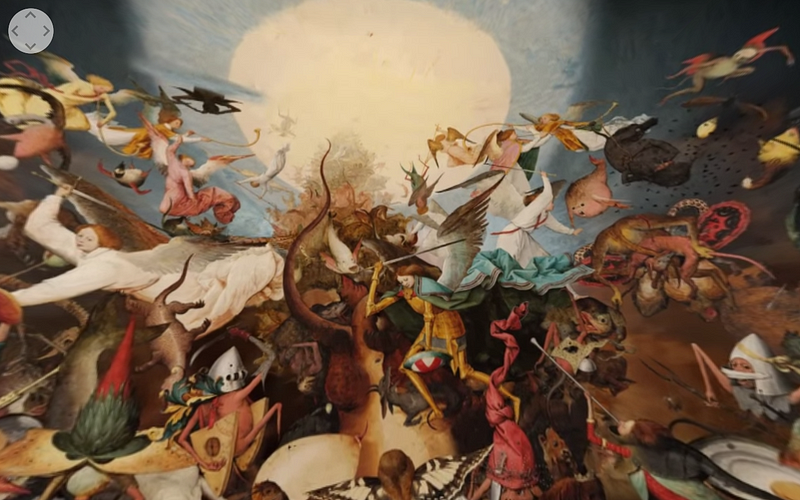 Google
Cultural Institute’s 360 VR piece “Bruegel: the Fall of the Rebel Angels”
Google
Cultural Institute’s 360 VR piece “Bruegel: the Fall of the Rebel Angels”Bruegel: the Fall of the Rebel Angels, March 2016
Faced with the challenges of transporting large scale works, Michel Draguet, Director General of Musées royaux des Beaux-Arts de Belgique, wanted a safe, more affordable way to bring his Renaissance artwork to a wider audience. Institutions from Brussels, Budapest, Berlin, and more coordinated with Google Cultural Institute to demonstrate how 360 video could do just that.
- Funded by: Google Cultural Institute
- Built by: Google Cultural Institute
- Accessible: 360 video or Google Cardboard VR (i.e. most smartphones)
- More info: Bruegel: Unseen Masterpieces
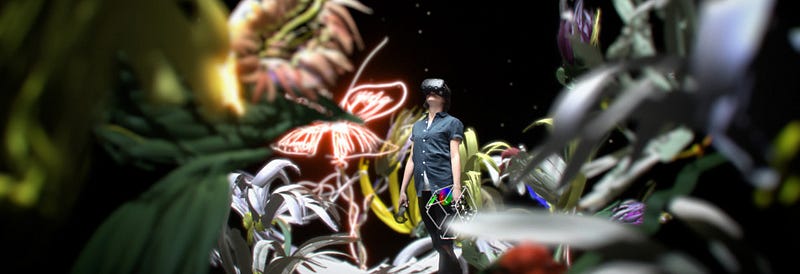 © Royal
Academy of Arts / HTC Vive
© Royal
Academy of Arts / HTC ViveVirtually Real, Royal Academy of Arts, January 2017
The launch of Google’s Tilt Brush on HTC Vive was a landmark moment in what felt like the birth of a new medium; art could be experienced in full 3D, completely enveloping the viewer. The Royal Academy was quick off the mark to involve the wider public, using off-the-shelf software to populate a dedicated exhibition, “Virtually Real.”
- Funded by: HTC
- Built by: RA students on Tilt Brush
- Accessible: On HTC Vive devices during the exhibition
- More info: Virtually Real
- Related project: From Life, the RA combine VR with life drawing
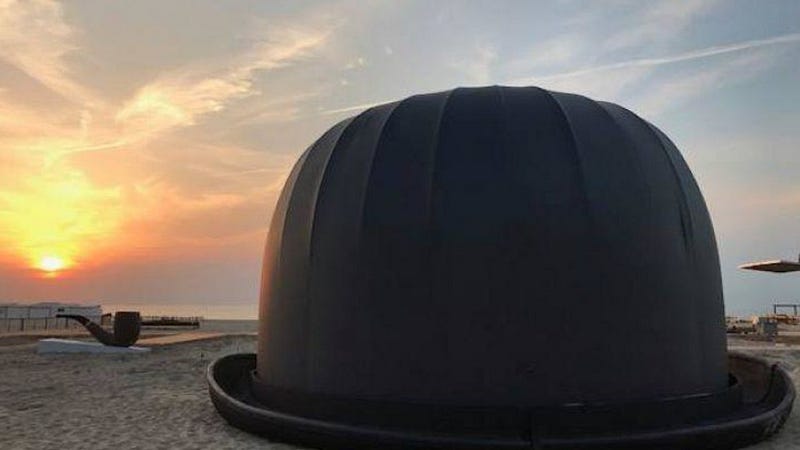 Magritte’s
VR cinema © C.H./ADAGP Paris / BDH
Magritte’s
VR cinema © C.H./ADAGP Paris / BDHMagritte VR, Summer 2017
Commissioned by the artist’s estate, marking 50 year’s since his death, this piece was delivered in true Magritte style, via a specially constructed giant bowler hat. The shared experience, for up to 50 people, was built over 6 months from hi-res scans of over 40 works.
- Funded by: the artist’s estate
- Built by: BDH
- Accessible: Dedicated installation, via Gear VR
- More info: BDH portfolio page
- Related project: Bosch VR
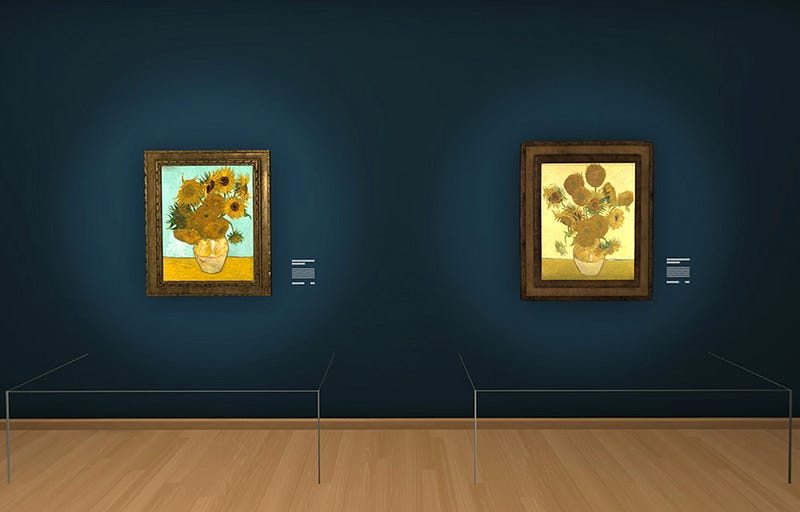 Van Gogh’s
Sunflower paintings reunited in VR © Visualise
Van Gogh’s
Sunflower paintings reunited in VR © VisualiseVan Gogh’s Sunflowers, Summer 2017
A project made possible by the power of the technology, here every Van Gogh Sunflower painting is reunited in a single gallery, narrated by the great-grandson of Van Gogh’s brother Theo. No less than five institutions teamed up to reunite these paintings: London’s National Gallery, the Philadelphia Museum of Art, Neue Pinakothek in Munich, the Seiji Togo Memorial Sompo Japan Nipponkoa Museum of Art in Tokyo, and, of course, the Van Gogh Museum.
- Funded by: Facebook
- Built by: Visualise
- Accessible: Only via Facebook
- Related project: The Night Cafe: A VR Tribute to Van Gogh
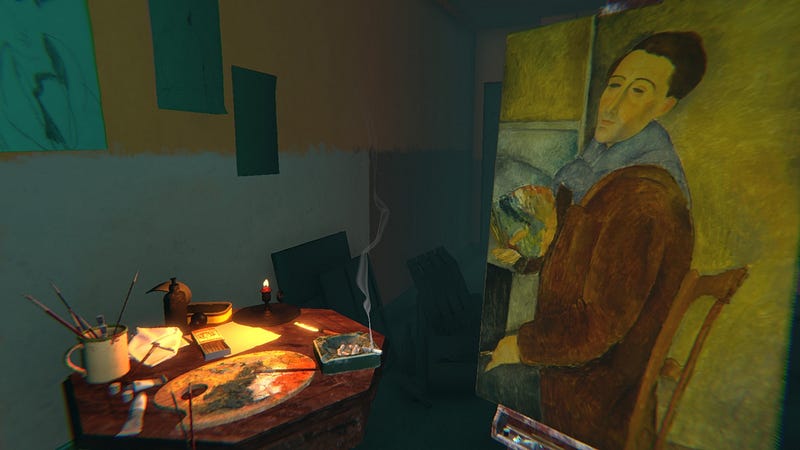 The Ochre
Atelier © Tate / Preloaded
The Ochre
Atelier © Tate / PreloadedModigliani VR: The Ochre Atelier, November 2017
One of the first of its kind, initially only accessible in a dedicated gallery space midway through Tate’s blockbuster retrospective. Visitors are transported to Modigliani’s 1919 Parisian studio, beautifully recreated in painstaking detail and all the more impressive given this studio has never been visited by anyone alive today.
Phil Stuart, creative director on the project, explains the approach: “Understanding art is about understanding the painter, the paintings and also the social and historical context. The opportunity with virtual reality and with this project is to try and deliver that in a very short experience that really gets you closer to those details.” Hilary Knight Knight, Head of Digital Content at Tate, adds, “You get that gut-feel understanding you don’t necessarily get from reading or looking at 2D pictures.”
- Funded by: HTC / Tate
- Built by: Preloaded
- Accessible on: HTC Vive in gallery (now closed) or at home via VivePort
- More info: On the Tate website
The evolving affordances of VR technology will continue to affect how the medium is used, but of more interest is why institutions and artists are using it. Over the last 18 months, three common themes have emerged, with a trend towards ever deeper immersion.
- Into the gallery — as one of the most widely accessible and low-cost formats, virtual tours are booming: Ai Weiwei 360, National Gallery 360, Smithsonian American Art Museum and more.
- Into the artwork — Animating existing artworks or creating new work exclusively for VR is technically more challenging but increasingly common. For example, Yinka Shonibare, Anish Kapoor and Marina Abramović
- Into the artist’s world — an emerging, creatively challenging approach that combines storytelling or gameplay to convey the emotions, motivations and deeper social/historical context. For example, Magritte VR and Modigliani VR.
As the capacity for deeper immersion increases, is it unreasonable to expect a future where the emotions and sensations of an artist can be piped directly into our brains? Throw in some haptic feedback and we may soon feel what Van Gogh felt in his famous moment of self-harm, or the joy of an incapacitated Matisse wielding his scissors with new-found flair.
That future may be some way off, but the industry has clearly learned to walk; how exciting to speculate what happens when it learns to run.
More examples of artists and art institutions embracing Virtual Reality…
- HTC Vive announces Mona Lisa: Beyond The Glass at the Louvre, revealing details invisible to the naked eye, coming October 2019
- Anthony Gormley gets in on the VR action, taking people to the moon for a fiver: Lunatick, at Studio X through April 2019
- Article on MuseumNext.com discussing VR in the Peterson Automotive Museum, The National Museum of Finland, The Smithsonian & The Tate (2019)
- Experience Claude Monet’s Water Lilies in VR at Musée de l’Orangerie in Paris (2018)
- BBC podcast by Adham Faramawy on new ways to create and experience art (2018)
- Not strictly VR, but an impressive immersive experience of Klimt’s masterpieces (2018)
- Excellent rundown by Vice of what it means to make Art in/for VR (2018)
- George Peaslee, Tilt Brush artist, recreates Edward Hopper, Van Gogh and more (2017/18)
- Mat Collishaw’s “Threshold” (2017) recreating a 1839 photography exhibition, allows visitors to move around the immersive environment
This piece was published in 2018, and updated as part of an issue of Immerse sponsored by the Knight Foundation in conjunction with their call for ideas to advance immersive arts experiences. Open for applications through August 12, the call offers recipients a share of $750,000 in funding, as well as optional technical support from Microsoft. Learn more.
Immerse is an initiative of the MIT Open DocLab and The Fledgling Fund, and it receives funding from Just Films | Ford Foundation and the MacArthur Foundation. IFP is our fiscal sponsor. Learn more here. We are committed to exploring and showcasing media projects that push the boundaries of media and tackle issues of social justice — and rely on friends like you to sustain ourselves and grow. Join us by making a gift today.